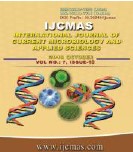


 National Academy of Agricultural Sciences (NAAS)
National Academy of Agricultural Sciences (NAAS)

|
PRINT ISSN : 2319-7692
Online ISSN : 2319-7706 Issues : 12 per year Publisher : Excellent Publishers Email : editorijcmas@gmail.com / submit@ijcmas.com Editor-in-chief: Dr.M.Prakash Index Copernicus ICV 2018: 95.39 NAAS RATING 2020: 5.38 |
Rice is the most important staple food crop in the world particularly in South East Asia and gets infested with gall midge which is an important pest especially during rainy season with delayed sowings resulting in huge losses to the farmers in Northern Telangana Zone, India. Forty five genotypes were studied for the estimation of genetic variability at Agricultural Research Station, Kunaram, Telangana. The GCV and PCV were high for number of grains per panicle, gall midge incidence and grain yield, whereas, low for days to maturity, plant height and panicle length. Additive gene action was predominant for number of grains per panicle, 1000-grain weight, gall midge incidence and grain yield as they registered high heritability coupled with high genetic advance values. Investigation on association studies expressed that genotypic correlation coefficients were higher than the corresponding phenotypic correlation coefficients except panicle length demonstrating that observed relationships between yield and yield components due to genetic causes. It is noticed that plant height, panicle length, number of productive tillers per m2 and 1000 grain weight exhibited significant positive association with grain yield, whereas, gall midge incidence expressed significant negative association with grain yield at both genotypic and phenotypic levels indicating the genotypes with more plant height, longer panicles, good number of productive tillers and long bold grains with relatively very less number of silver shoots contribute for high grain yield and gall midge resistance.
 |
 |
 |
 |
 |